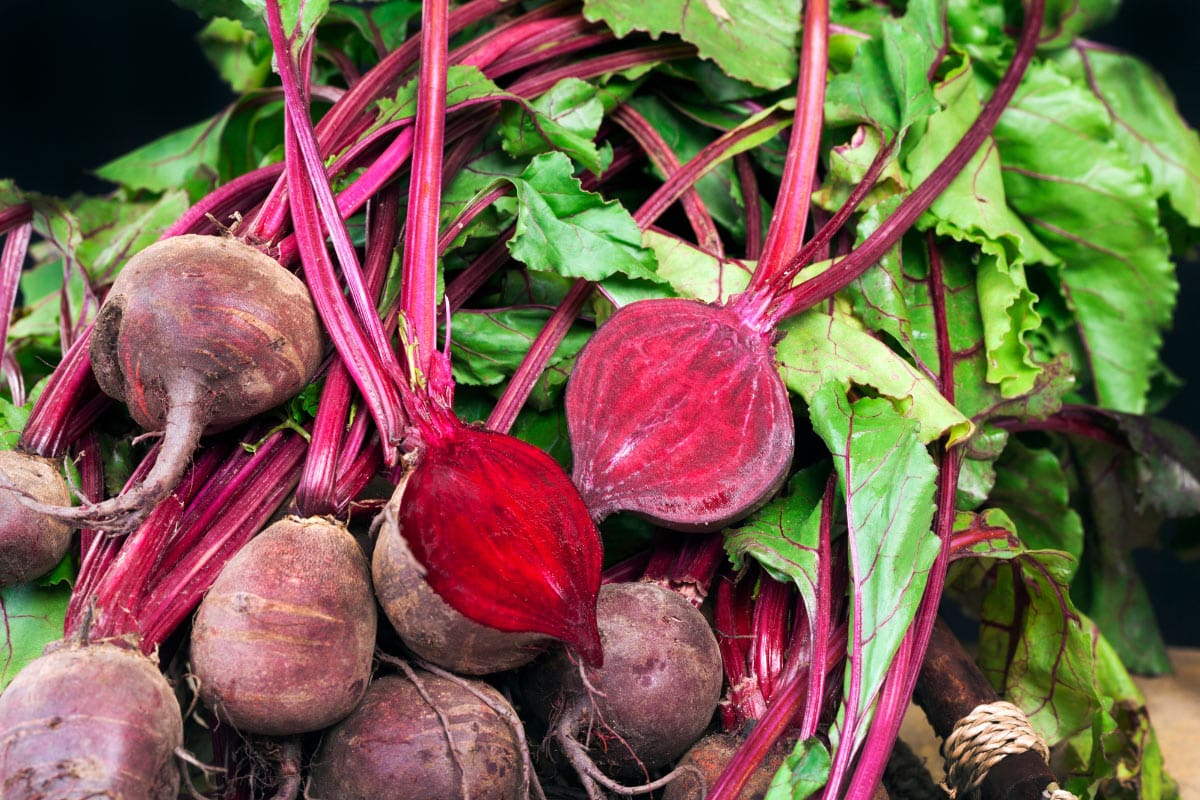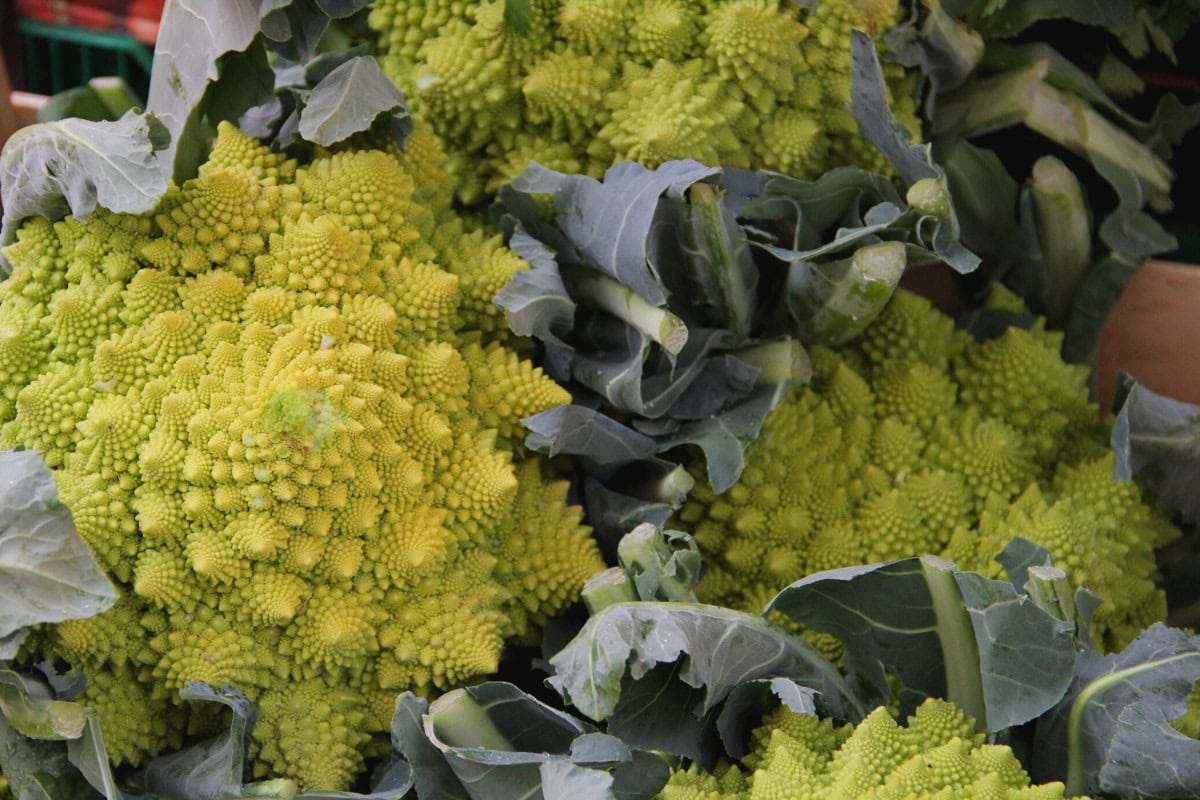Biggest Ever List of Vegetables That Start with B (25 ideas)
HurryTheFoodUp is reader-powered. If you click through using links on our site we may earn a small commission at no cost to you.
Ever struggled to think of a vegetable beginning with B for a game like ‘boy, girl, fruit, flower’ or I spy? Struggle no more with the biggest-ever list of vegetables that start with B!
From the most obvious, like bell peppers and broad beans, to the downright unusual (ever heard of black salsify?), I’ve rounded up a pretty comprehensive list!
If you’re wondering just how I managed to come up with 25 vegetables that start with the letter B, allow me to explain.
I’ve selected what are considered culinary vegetables, meaning veg that’s considered vegetables in cooking, and not necessarily in botanical classification.

So, bell peppers are botanically a fruit, but would be very out of place in a fruit salad. So, bell peppers are a culinary vegetable.
I’ll also admit there are a few vegetables here that I’ve never been lucky enough to cook with, so do let me know in the comments if you have experience using black radish or burdock root in your cooking, for example!
25 Vegetables beginning with B
Without further ado, let’s get into this comprehensive list of vegetables that start with B, from the boring to the brilliant to the bizarre!
Bamboo Shoots
Bamboo shoots, also known as bamboo shoots, are the edible shoots of the bamboo plant.
They’re available in fresh, dried or canned versions, and if you can’t find them where you usually shop, try a nearby Asian supermarket since they’re a staple of Asian cuisine from Nepal to Taiwan!
Their flavour is similar to water chestnuts, subtly earthy and slightly nutty.
They’re eaten in a myriad of ways, but usually prepared with stir fries or stewing – beware that boiling for too long can swiftly lead to overcooking and a loss of their lovely, crunchy texture.

Banana Squash
Another vegetable beginning with B (unless you’re using its species name which is Cucurbita maxima), but is less common that the butternut squash, is the banana squash!
It’s similar to it’s butternut cousin in taste (sweet, nutty) and in that it’s a winter squash (hard skin, harvested in full maturity).
If you know one thing about banana squash, know that it is that MASSIVE!
They can grow as long as three feet, so while it’s unlikely that you’ll have seen a full size banana squash in the grocery store, if you ever bought pre-packaged squash, you may have bought this type of squash!
Bean Sprouts
Bean sprouts come from, you guessed it, sprouted beans! Most bean sprouts are the green-capped mung bean and the yellow-capped soy bean.
They are extremely popular in South and Southeast Asia, and while they don’t have incredible nutritional value, as vegetables go, they have a subtle flavour and a great, crunchy texture.
Beetroot/ Beets
Known as beetroot in the UK and beets in America, it is the taproot section of the beet plant (whose leaves are also edible and known as beet greens).
Beetroots can be eaten raw, boiled or roasted and taste earthy and slightly bitter.
Beetroot soup, such as Borscht, is common in Eastern Europe, while chopped and spiced beetroot is a common side dish in Indian cuisine. Its species is Beta vulgaris.

Belgian Endive
Belgian endives are a small head of lettuce.
Although, this description does them rather a disservice, so, more accurately: belgian endives are a small but expensive vegetable that has a slightly bitter taste and are grown slightly below the soil in dark rooms to preserve their pale yellow colour and delicate flavour.
They are often added to salads but can also be eaten baked or grilled. They also originate, as the name suggests, from Belgium. No surprises there. Its species name is Cichorium intybus var. Foliosum.

Bell Peppers
Bell peppers are a crunchy, sweet and vitamin C-filled addition to many cuisines. They are commonly found in red, yellow, orange and green colours but also come in purple, chocolate and striped varieties.
They are technically a fruit of the species Capsicum annuum but are usually used in savoury dishes. They are native to Mexico, Central America and Northern South America, and are delicious stuffed as a main course.
Bitter Melon
Bitter melon (aka Momordica charantia) is a type of tropical vine that belongs to the gourd family. It’s closely related to courgette/ zucchini and pumpkin. It is cultivated around the world but is a staple in many Asian countries.
There are Indian and Chinese varieties of bitter melon which differ slightly in appearance but both are long and green with uneven skin. A study has found that taking bitter melon extract may help regulate blood sugar levels.

Black Beans
Black beans, also known as black turtle beans or Phaseolus vulgaris, are particularly popular in Latin American cuisines.
Native to the Americas, black beans are popular in vegetarian cooking thanks to their hearty, almost meaty texture and high protein and fibre content.
If you fancy incorporating them into your cooking, why not try these Venezuelan black bean arepas con queso?
Black Eyed Peas
Not to be confused with the popular band of the same name, these legumes are an excellent source of fibre and so are great for supporting digestion. Their species name is Vigna unguiculata.
Black-eyed peas originated in West Africa, and have been grown in Virginia since the 17th century, when enslaved people brought plants from their homeland with them.
Today, they’re a staple of soul food and other cuisines from the southern states of the US.

Black Radish
Although relatively uncommon now, black radishes were the most popular variety of radishes in Europe in the Middle Ages.
It’s not enough to make me want to time travel, but I do wish black radishes were more easily available today!
Black radishes, like the more common red coloured variety, are sharp and can be eaten raw or cooked. Adding salt to the radish while raw can help to reduce the strong taste. Its species is R. raphanistrum.
Black Salsify
Black salsify is already easily the best named B vegetable on this list, but if you’re feeling adventurous you could also call it serpent’s root or viper’s grass.
These names derive from the widespread belief that it’s a good antidote to snake bites. Personally, I’d rather just get medical attention ASAP but I guess it could be worth a shot if you’re out of other options.
It is a root vegetable with yellow flowers and a long smooth stem whose scientific name is Scorzonera hispanica.
Bok Choy
Bok choy (Brassica rapa subsp. chinensis) is a type of Chinese cabbage that is traditionally used in stir fries and soups in a similar way to cabbage and other leafy greens. It can also be eaten raw, and in Britain, it’s also known as pak choi.
The green leaves of bok choi have a stronger taste than the white centre, but the taste is nonetheless mild and slightly sweet with a slight peppery undertone.

Boniato
Boniato is similar to a sweet potato but not quite so sweet. It has dry, white flesh and pink skin.
The name could be loosely translated from Spanish as ‘harmless’, a name given to it by Spanish conquistadors who needed to differentiate it as edible from other poisonous plants that they encountered.
Its scientific name is Ipomoea batatas. Use it by substituting it for sweet potato in these tacos!
Broad Beans
These are also known as fava beans, or vici faba if you’re feeling official, and are a flowering plant in the pea and bean family Fabaceae. They grow in most soils and climates due to their hardy nature.
Broad beans are also grown as a cover crop as they help to prevent soil erosion and extracting excess nitrogen from the soil. I never knew a simple bean could be healthy for us and so good for the environment too!

Broadleaf Arrowhead
This is a plant found in wetlands, also known as Indian potato, which produces edible tubers that have long been a staple of Native American cooking.
The starchy tubers float to the top of the water they are grown in, and can be eaten raw or prepared in much the same way as potatoes. Its scientific name is Sagittaria latifolia.
Broccoflower
Also known as Romanesco broccoli, and winning the award for the most beautiful vegetable probably ever, the broccoflower is the edible portion (the immature flower head) of the species Brassica oleracea.
It was first documented in Italy in the 16th century, and the number of spirals on the head of the broccoflower is always a Fibonacci number.
The broccoflower tastes rather like normal broccoli but the striking patterns on the flower head may mean you never want to cut it up to eat it!

Broccoli
This delicious vegetable (Brassica oleracea var. italica) is another member of the cabbage family, just like brussels sprouts.
The word broccoli comes from the Italian plural of broccolo, the diminutive form of brocco, meaning ‘sprout’ or ‘small nail’, which, when you think about a broccoli floret creatively, kinda makes sense. Add garlic roasted broccoli as a side to your next meal!
Broccoli Rabe
Also known as rapini, broccoli rabe is among the best cruciferous vegetables for vitamin C and A content and the health benefits they herald. It has a bitter taste and although its leaves resemble broccoli, they do not form a large head.
This leafy green vegetable is particularly associated with Mediterranean, especially Southern Italian cooking. Its species name is Brassica ruvo.
Broccolini
Broccolini is not just regular broccoli’s baby sibling, but a hybrid between broccoli and gai lan (a.k.a Chinese broccoli or Chinese kale). Its creation took over 8 years of development and it was first grown commercially in 1994.
This vegetable is very popular in the United States with the most broccolini in the world being grown in Arizona and California.
It’s popular with good reason too, as it’s sweeter and more tender than regular broccoli though can be used in much the same way. Its species name is Brassica oleracea var. botrytis.

Brooklime
Brooklime is a perennial sprawling herb that grows at the shore of rivers and in wet meadows and marshlands. Brooklime, along with watercress and oranges, was once eaten to help prevent scurvy.
Now, it is used largely as a decorative floral herb in salads. Veronica beccabunga is its scientific name, which would just as equally suit the spoilt protagonist-in-need-of-a-lesson in a children’s film.
Brussels Sprouts
They get an unfairly bad rap but it’s estimated that British supermarkets sell around 750 million brussel sprouts every Christmas time!
Brussels sprouts are actually the edible bulbs of a larger cabbage plant (the Gemmifera cultivar group of cabbages).
They’re surprisingly great in salads and derive their name from Brussels, in Belgium, where they have long been popular.
Brussels sprouts have a cabbage-like taste, and I find it’s important not to overcook them as this impacts their flavour – roasting or frying them are great options to avoid this!
Burdock Root
The burdock plant has long, dark roots, though is often eaten in other forms like burdock tea or burdock oil. If eating burdock root whole, you must first peel it and then boil, sautee or fry it.
This root vegetable has long been used in traditional medicine and there is evidence to support its antioxidant and anti-inflammatory effects. In case you were wondering, its scientific name is Arctium lappa.

Butter Lettuce
Sweeter than regular lettuce, butter lettuce is a great source of vitamin A, vitamin C, vitamin K, calcium, and iron. It comes in both green and red leaf varieties and would work perfectly in these Korean inspired lettuce wraps.
Its species name is Lactuca sativa.
Buttercup Squash
Like butternut squash, this is a winter squash (Cucurbita maxima) that has a nutty flavour.
Buttercup squash is round and dark green and contains lots of beta-carotene and alpha-carotene for vitamin A, as well as vitamin C, which helps with immunity.
Despite being a somewhat unusual squash, your best chances of getting your hands on a buttercup squash are in the winter, when they are in season.

Butternut Squash
This is a winter squash (or, by its species name, Cucurbita moschata), meaning it is harder skinned compared to summer squashes like courgettes/ zucchinis.
Butternut squashes, along with other types of winter squash, were one of the three main agricultural crops of indigenous peoples throughout North America (known as the Three Sisters).
Butternut Squash has a sweet and nutty taste, a hard rind and an orange flesh.
Although squash was first domesticated almost 10,000 years ago, butternut squash was created rather later, in 1944, by crossing the pumpkin and gooseneck squash varieties.
Biggest Ever List of Vegetables That Start with B (25 ideas)
Ever wondered just how many vegetables that start with the letter B you know? We bet you can’t guess all 25 of these!
- Bamboo Shoots
- Banana Squash
- Bean Sprouts
- Beetroot/ Beets
- Belgian Endive
- Bell Peppers
- Bitter Melon
- Black Beans
- Black Eyed Peas
- Black Radish
- Black Salsify
- Bok Choy
- Boniato
- Broad Beans
- Broadleaf Arrowhead
- Broccoflower
- Broccoli
- Broccoli Rabe
- Broccolini
- Brooklime
- Brussels Sprouts
- Burdock Root
- Butter Lettuce
- Buttercup Squash
- Butternut Squash
So, there’s my list of vegetables that start with B. Which ones have you never heard of before? What’s the most unusual vegetable beginning with B that you’ve cooked with?
I’m genuinely curious to hear your answers so do let me know in the comments.


